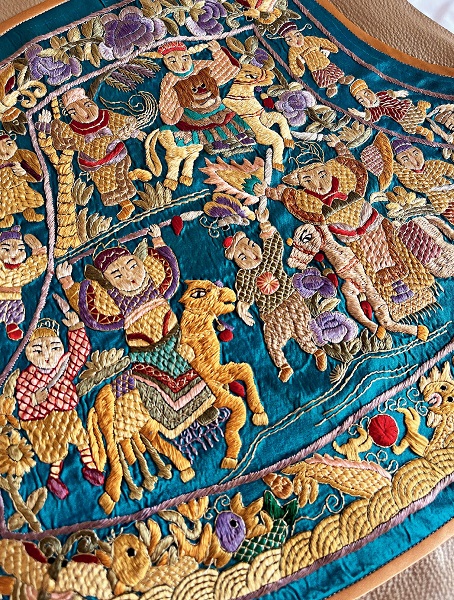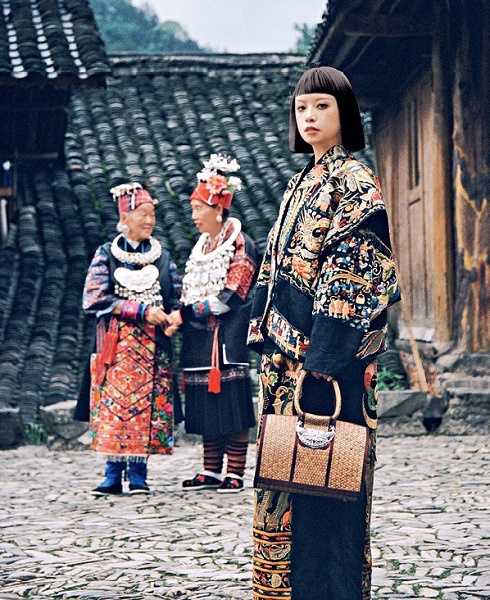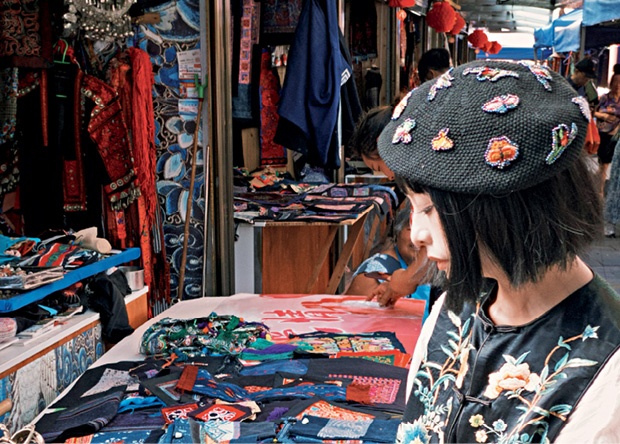
A hunting scene forever frozen in thread.
Lacking a unified writing system, the ancestors of the Miao people, an ethnic group primarily living in mountainous areas in central and southwestern China, encoded their history in the exquisite design of traditional clothing, especially embroidery. They express reverence for nature and appreciation of life with needles and threads.
The techniques and styles of Miao embroidery vary between regions and even villages, resulting in the forming of more than 100 different schools. Under the nimble fingers of local women, folklore, historical events, and natural scenes are brought to life on textile in stunning colors.
In recent years, the fashion world has taken new interest in ethnic culture. Riding this trend, a twentysomething Miao designer Zhang Liyue is dedicated to bringing the embroidery of her hometown out of the mountains onto the global stage. The Miao-style embroidered dresses she co-designed have won international attention and commendation.

Zhang Liyue (right) and two embroiderers at a Miao village market.
 From Ethnic Costumes to Daily Apparel
From Ethnic Costumes to Daily ApparelFrom the butterflies stitched on her coat to colored threads stashed in her mother’s vanity case, Miao embroidery has been part of Zhang’s life since her childhood in a mountainous village of Guizhou Province. Both her grandmother and mother were collectors and sellers of Miao embroidery, and Zhang herself began at an early age to learn different traditional crafts like embroidery, paper-cutting, and batik under their tutelage.
After graduating from college, she worked in the fields of visual design and display, fashion photography, and brand marketing in two of China’s southern metropolises – Guangzhou and Shenzhen. As time went by, she gradually grew tired of fashion’s fast fleeting nature, and began to reflect on how traditional ethnic attire could find new relevance in today’s culture.
One day after hearing that the works of an embroidery master from her hometown had been displayed at a Parisian museum, she came to the realization that Miao embroidery should grace the lives of more people as a timeless cultural symbol instead of being confined to one ethnic group. In 2023, she left her job to fully dedicate herself to introducing this intangible heritage into the wardrobe of young urbanites.
In order to carry out her mission, Zhang returned to her hometown Kaili, a county-level city in southwest China’s Guizhou Province. After immersing herself in local embroidery, she launched her own fashion brand XUYI.
But the start-up encountered far more challenges than she had anticipated. One of those challenges was to solve the contradiction between the slow Miao embroidery and the fast-changing modern fashion industry. The making of Miao embroidery is labor-intensive and time-consuming, whereas the modern fashion industry expects fast speed so that products can be both ready-to-wear and affordable, pretty and practical. In this sense, embroidered clothing seems to be at odds with today’s fast-paced urban life.
After extensive exploration of the market, Zhang finally decided on the development direction of XUYI’s products: be a bridge between tradition and modernity. Embodying neo-Chinese aesthetics, it integrates iconic Miao motifs and patterns with modern tailoring. The result is a seamless fusion of intricate embroidery and clean cuts. Vests, coats, shawls, or hats, XUYI products exhibit a beauty that is truly one of a kind, emanating understated Oriental elegance in all surroundings, whether it be urban streets or countryside fields.

Fancy coats made with lavish Miao embroidery.
Haute Couture with a Soul
“What impresses me most about Miao embroidery is its expressiveness in telling stories with needles and thread,” Zhang Liyue said. “We Miao people traditionally believe in animism – that mountains, rivers, and plants all have souls. To us, embroideries are love letters from our ancestors to mother earth.”
With this belief, she employs traditional stitching techniques to recreate classic Miao motifs, such as Butterfly Mother (mythical figure who gave birth to the Miao people), Starry Skies of the Migration Trial, and Farming Scenes. This craftsmanship which is done by hand imbues contemporary design.
It takes two to 12 months to make a garment using Miao embroidery techniques. As one embroiderer observed, “Today’s young people often discard clothes in three months, but ours endure for three generations.” Gradually, this sustainable fashion has won over more fans not only among China’s younger generation but also those from around the world.
“Our most distinctive line of products that is popular among international customers are overcoats embroidered with Miao motifs,” Zhang said. “They represent supreme craftsmanship – simple pieces in crisp silhouettes adorned with finely stitched Miao motifs, such as mythology, farming scenes, flowers, birds, fish, and other natural elements. These styles of clothes give the wearer a feeling that they are being embraced by nature.”
This view echoes among her customers. A French buyer commented, “Mysterious and full of life, these motifs remind me of Picasso’s paintings. Miao embroidery is not exotic wear, it is haute couture appropriate for both art shows and cafés.” A Japanese client ordered a hand-embroidered base layer to match her modern dresses, calling it “wearable ethnic DNA.”

Zhang Liyue often browses stores that sell custom embroidered patches, searching for creative inspiration.
Empowered by New Technology
During recent years, Miao embroidery has gained more prominent attention at international fashion weeks and art exhibitions. Works of Miao embroidery master Pan Yuzhen were shown at the Milan Fashion Week. And the ethnic fashion brand Gu Axin appeared at the London Fashion Week, blending Miao embroidery with streetwear.
Behind this growing popularity is the joint efforts of masters of this intangible cultural heritage to adapt traditional craft with modern taste and enhance its classic charm with high technology.
Long Luying, a Miao embroidery master and entrepreneur from Guizhou, partnered with Guizhou University in creating a Miao embroidery digital platform, which uses new technologies, such as data collection and analysis, digital processing, and artificial intelligence, to promote this traditional craft. Her company also collaborated with the clothes brand Jeanswest and fashion designer Huang Gang to create a full-dimensional effect for traditional butterfly motifs by using 3D-printing and bio-based fibers.
These pioneering acts have deeply inspired Zhang Liyue and reinforced her own conviction that to help traditional crafts survive and thrive in the modern era, “we must open new paths of development while preserving their cultural roots.”
Today, in addition to making collector-grade garments with lavish embroidery, Zhang’s workshop also develops lightweight items used in everyday life, embedding embroidered patches into keychains, bag charms, gift boxes, and tea ceremony mats. This year Zhang took the innovative step of incorporating ethnic motifs into home decor and appliances, such as lighting installations. In this way, she is continuously instilling new blood into the static cultural heritage.
“Rather than simply selling products, I want to show people how the Miao people engage with the world,” said Zhang Liyue. Looking ahead, she is planning to create short videos in the future to document female Miao embroiderers, the ingenuous artists living in mountain recesses.
Currently, her focus is on developing more creative products in collaboration with local embroiderers, and hence generating more employment opportunities to support rural revitalization. This is only the first step toward achieving a bigger ambition. As Zhang said, “I'm a sapling that extends its roots deep into the ground while stretching its branches toward the sun. Slowly, I will grow into a towering tree.”